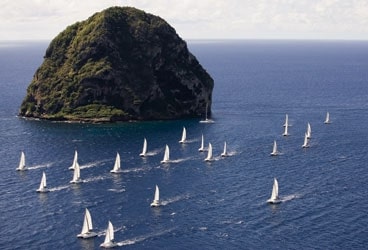
Martinique 368
More than the usual adrenaline flow courses through me as I steer our Sunsail-chartered Bahia 46-foot cat toward the starting line set off Martinique’s Le Marin. We’re supposed to turn downwind once the gun fires, and one minute before the signal, a dozen boats are already maneuvering close to the imaginary line. Fortunately, the wind is light, and when a 40-footer with a Caribbean-costumed crew stalls directly in front of us, a quick course change keeps us clear.
When the starting signal sounds, the fleet fans out on opposite jibes. Suddenly, a 38-footer scoots several lengths ahead, then slows down dramatically. I’m puzzled, then chuckle, realizing I’ve just witnessed some good tactical use of the engine. Maybe I should relax a little.
But let’s call it “concentrated relaxation.” It’s not easy to sail the right broad-reaching angle to keep the jib working while the half of the fleet flying spinnakers gradually leaves us in its wake. After a while, we jibe and cross tacks close behind another cat-suddenly they’re signaling at me and pointing to their wake. Uh-oh! They’re trolling a few fishing lines, and we just clear them, but look-the pirate on the bow of the boat next to us nearly gets hooked.
After one leg of one race at the Fountaine Pajot 30th-Anniversary Rendezvous, held last November off this beautiful island in the French West Indies, I’m getting the picture: Nobody is going to lose any sleep over the results. Unless we’re talking about who will win the award for the best crew outfits or biggest fish caught.
I’m sure there are a few serious racers in the fleet of two dozen Fountaine Pajot models, but I never find one. Joe Place, a Belize 43 owner from Washington, D.C., has chartered Images III, a Bahia 46, and admits after the event that as he got more friendly with Steve Chelinsky’s Las Vegas team on Double Down, also a Belize 43, he tried harder to beat them. “I have a lot to learn about the fine points of sail trim,” he says, then adds that the Belize, a newer model, is a bit faster.
I agree with him completely, as I spend most of the first two days unable to keep pace with Moby Lou II, Pierre-Marie Pasquier’s Belize 43. But then, looking at the final results of the three-day, three-race event, I notice a Bahia 46 at the top of the standings, Jean-Michel Lecocq’s Moana III.
All too soon we’re at the final awards party. Some 20 Fountaine Pajot cats lie at anchor off Martinique’s spiffy new Club Med while more than 100 guests are laying waste to the buffet tables, emptying bottles of wine to chase the rum cocktails, and watching brightly dressed youths of Martinique perform traditional dances. It’s a scene Jean-François Fountaine and Yves Pajot couldn’t have imagined when they built their first little boat 30 years earlier. For one, these guys were racers-Yves sailed in the Olympics, and Jean-François navigated a transatlantic-winning maxi-cat. Even today, their general manager, Eric Bruneel, takes time off to race-and not just on weekends. For this regatta, he’s flown in from Guadeloupe after a solo transatlantic on his 50-foot racing trimaran.
According to Eric, the company used to build higher-performance cats, but it found that many more people preferred simpler designs. Instead of slim hulls with daggerboards, the boats grew beamier, with shallow-draft keels protecting the rudders and saildrive units. So the upwind tacking angles are modest, especially in light winds, but the boats can still hum along on a reach.
For one week the Fountaine Pajot brain trust has traded styrene fumes for ti punch and is enjoying relaxed sailing, swimming, dancing, and some quiet time to celebrate with owners their 30 productive years building some 1,600 boats.
One owner, George Florit, of Los Angeles, later tells me how impressed he is that company managers are simply there to thank participants for their ownership of their boats and to answer any questions while never pushing “sales” themes. Aboard Bendicion, a Bahia 46, George sailed up from Grenada-where the boat spent hurricane season on the hard-and arrived in Martinique apprehensive about the event and not sure that he’d stay. “I was hooked by the hospitality,” he says, “from the moment I arrived.” George had never been in a rally before, but three days of sailing and three nights of parties later, Bendicion finished seventh, and its owner had an experience he would never forget.
Writing this story some months later, I recall many other experiences. My favorite sailing day came, perversely perhaps, when it rained. My number-one crew, Bruce Nance, and I had survived being abandoned by our wives and other crew after the first race (this was planned, not spontaneous). At the bar that night, we shanghaied Malcolm Turner, of the British magazine Multihull Review and the next day had our best race of the weekend. Here’s how I remember it:
In the stillness before the rain, the spinnaker boats ahead have lost way against the current at Cap Salomon. Alongside Moby Lou II, we catch up by tucking in close to the point. Gradually we turn upwind in fluky air toward Baie de Fort-de-France, and soon the wind and rain arrives. Predictably, Moby Lou II pulls away again, but there’s only one other boat ahead of her. As the breeze builds, Bruce and Malcolm grind in the sheets, and soon the 19,000-pound cat is charging upwind faster than seven knots. The breeze doesn’t last, nor does the rain, but we hold our place and drift across the finish line. Now it’s time for the party. Tomorrow, we’ll do it over again.
John Burnham is the editor of Cruising World.








